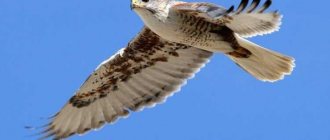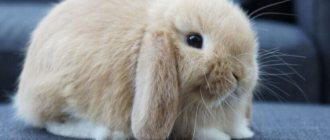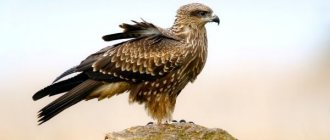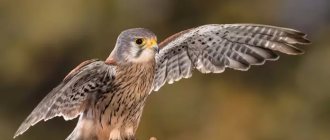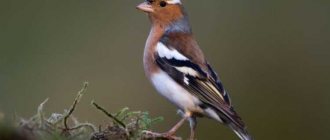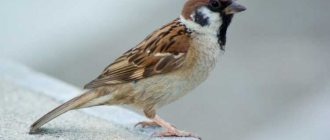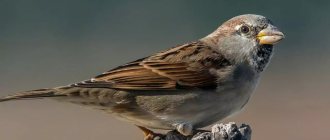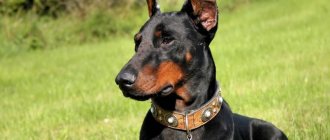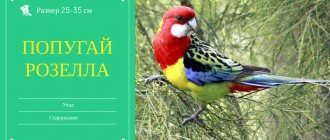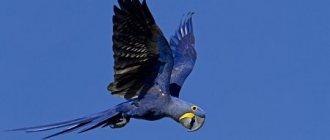Review author: “ZooVita”
Parrots are the most common birds that are used by humans not for hunting, but only for decorative purposes. The names of parrots are as varied as their appearance.
Living in tropical countries, these unusual birds are divided into more than three hundred species. There are species of talking parrots that can repeat heard sounds and even human speech.
There are about 400 species of parrots in the world
A parrot is a large group of birds with curved beaks and often brightly colored plumage. There are about 400 known species of parrots, but, unfortunately, many of them are now in danger of complete extinction.
All parrots belong to the taxonomic order Psittaciformes. Researchers divide these birds into three main groups or superfamilies: true parrots, cockatoos and New Zealand parrots. They come in different shapes, sizes and colors. The plumage can be orange, green, blue, yellow, red, black, white and multi-colored. The size of the bird varies from 8 to 92 cm in length!
Photo: Tam Nguyen
Population and species status
Parrots, as representatives of the species, have existed since the fifth century BC. For several millennia, the bird was exterminated because of its bright and beautiful plumage, and was caught for keeping in captivity. Active deforestation has also contributed to the decline in the number of such birds. Some species have already disappeared completely or are on the verge of extinction. Currently, the following are listed in the Red Book (IRC):
- Australian native parrot;
- Seychelles island parrot;
- some subspecies of Amazon parrots;
- grass common parrot;
- kakapo (night or owl parrot).
Kakapo is considered to be extinct in its natural habitat, so representatives of the species are kept today only in private nurseries and reserves. In addition to those listed, rare species include the Inca cockatoo, blue macaw, golden aratinga, royal amazon, as well as the Cuban macaw and Solomon cockatoo.
The conservation of rare species is carried out at the state and international level. For this purpose, the number of wildlife sanctuaries and reserves is increasing, and birds are being bred in captivity with the subsequent release of birds into their natural habitat. The fight against poaching and the ban on the illegal export of rare birds from the country are also considered effective.
Return to content
Parrots live mainly in the Southern Hemisphere
These birds live in a wide variety of habitats, but most are found in tropical or subtropical regions. In the Western Hemisphere, they are found from Mexico to Central and South America, as well as on nearby islands. They also inhabit sub-Saharan West Africa, India, Southeast Asia, Australia and the islands adjacent to the continent.
Different species have different ranges, and some populations overlap with populations of other species. Different species prefer different types of habitat: mixed, tropical and palm forests, savannas, meadows, desert margins. Some species live in city parks, gardens, farmland and highlands.
Popular questions
What are the main differences between parrots and other birds?
The parrot cannot be confused with anyone. Look at its massive, down-curved, strong beak. And parrots use it very skillfully. Their beak serves as a device for capturing and grinding food, for climbing trees (just like a third leg), and can also be a formidable weapon. In addition, the parrot has short but developed legs. They help the bird to hold onto the fruits it has caught, and they are also used by the parrot to bring food to its beak.
How many species of parrots are there and where do they live?
There are more than 330 species in the Psittacidae family, and another 20 are part of the cockatoo family, which are also members of the Psittacidae order. All these birds are very thermophilic, which is why they live in subtropical and tropical climates. The most numerous colonies of parrots are in Australia. They are also widespread in the forests of Southeast Asia, West Africa, South and Central America. And a huge number of parrots live in our houses and apartments, because this bird is easily tamed.
What parrots talk?
Parrots differ from other birds not only in the rich colors of their plumage, but also in their ability to “talk.” Of course, parrots do not speak, but only imitate human speech, but this is a very great achievement for a living creature: after all, no one except parrots in the animal world has such an ability. Scientists involved in research into the life and characteristics of parrots claim that the whole point is in the special structure of the speech organs, in particular the language, thanks to which parrots copy human words, perceiving them as the sounds of their “relatives”.
As it turned out, almost all parrots can “speak” and not all of them can accurately reproduce the voice and words of a person. The ability to repeat words after people manifests itself differently in different species of parrots. The best imitators of humans are gray and Amazon parrots, cockatoos and macaws . And gray Jaco parrots copy not only the sounds of human speech, but also the intonation and even the features of the voice. All these birds are usually grouped together under the name " talking parrots ".
What is the most popular pet parrot?
One of the most popular pets in our country is the budgerigar. It got its name from the wavy stripes on its plumage. This small bird loves to make noise and is talkative. Budgerigars remember words and entire expressions quite easily. In the wild, these birds live in Australia, where they roam from place to place in huge flocks in search of food and water.
What is the largest parrot in the world?
In the South American jungle there lives a large parrot with blue-cobalt plumage - it is impossible not to recognize it. This is a hyacinth macaw. The body length of this giant can reach 1 meter, and its weight can reach 1.5 kilograms! The bird has a massive black beak, and at the base of the mandible there is a wide golden stripe. The loud and sharp guttural voice of this parrot can be heard at a distance of more than a kilometer from the bird’s location.
What is the life expectancy of parrots?
Contrary to the common misconception that the lifespan of parrots can reach 100 years or more, this is by no means true: it is rare for their age to exceed 50 years. Although there is information about parrots 65–70 years old.
According to the Green Parrot Bird Hospital, the life expectancy of budgerigars in captivity is 12-13 years, with 1 in 100 budgerigars living to be 16 years old, and 1 in several thousand budgerigars living to be 18-19 years old. Also, in the bird hospital, the life expectancy of Cuban Amazons in captivity was determined precisely - they reach old age at 35 years, and they practically do not overcome the 40-year life threshold.
Which member of the parrot family lives the longest?
This is a gray parrot, or gray parrot.
Its average lifespan is approximately 60 years. However, some individuals live up to 90! The gray's body length is 30 centimeters. It has a black curved beak and gray feathers. Jaco has a high intelligence and excellent ability to imitate.
Parrots are one of the most intellectually developed birds
Parrots learn well and quickly. They are able not only to learn words, but also to associate them with objects or circumstances. They are also able to imitate the sounds of other animals and copy various sounds of the environment. African gray parrots, Amazons and macaws imitate sounds best.
But parrots do not have vocal cords. They make sounds with their trachea as they push air out of it. Birds change the pitch of their sound by changing the shape and depth of their trachea. When parrots talk, they really just whistle.
Parrots can use assistive tools and solve puzzles. Some individuals were even taught to read, count, and collect objects by shape and color. Scientists say that parrots have an IQ equivalent to that of a four-year-old child. Parrots are very playful birds, and games are known to promote intellectual development.
Interesting facts about parrots
- Parrots are unsurpassed sound imitators: they imitate human speech, reproduce animal sounds, and even try to repeat pieces of music. Moreover, birds perform all these masterpieces of imitation only with the help of their mouth, tongue and beak, since parrots do not have vocal cords.
- The black cockatoo has the largest beak among parrots: it reaches a length of 10-13 cm. It is not surprising that with such a “tool” the bird can easily bite through thick branches and can even snatch a person’s finger.
- Due to their excellent ability to quickly get used to new living conditions and not suffer from changes in their usual environment, parrots were often tamed by sailors setting off on long voyages. The feathered companions happily traveled on ships and brigantines across countries with their owner, without experiencing any discomfort.
- Unlike many living creatures on the planet, parrots remain faithful to their spouse all their lives.
- Being socially organized, parrot birds create populations of more than 70 thousand individuals.
- Among birds, parrots are considered long-lived - representatives of especially large species can live up to 100 years.
- The weight of a newborn budgerigar is only 2 grams, and an adult woodpecker parrot, living in Papua New Guinea, weighs 11.5 g with a height of 9 cm. But not all parrots are small: the Amazon parrot grows up to 1 meter in height.
- Thanks to monocular vision, a parrot can use each eye independently of the other, with a viewing speed of 150 images per second, compared to only 16 for humans.
- Like humans, a parrot can be right- or left-handed.
- The gray parrot became famous for its knowledge of languages and a rich vocabulary of 400 words, and therefore was included in the Guinness Book of Records.
- Parrot owners living in Australia have the opportunity to send their feathered friend to a school, where even the most silent and uncommunicative pet will be patiently taught spoken language, and then examined and assessed for achievements.
- In Australia, for example, drunken parrots periodically fall from the sky, frightening and perplexing residents. It turns out that birds eat special plants, the juice of which instantly has an intoxicating effect on the birds.
- Parrots are very musical and have a wonderful sense of rhythm. The band Hatebeak, which has released 3 albums, has Waldo the parrot as its vocalist.
- Among these cute feathered creatures there are also dangerous predators: for example, kea parrots hunt sheep.
Video
Parrots are the only birds that can feed with their paws
Parrots have zygodactyl feet, that is, they have four toes on each foot, two of which face backward and two forward. They have very powerful paws, allowing them to hold on to branches for a long time and even swing or hang upside down on them. However, that's not all they use their paws for.
Photo: David Clode
A parrot's feet are like human hands. They often use one paw to grasp food, branches and other objects, while using the other paw to balance their body. Parrots literally eat with their paws, bringing food to their mouths. It has even been observed that parrots prefer one paw over the other. Therefore, just like us humans, parrots can be left-handed or right-handed.
Photo gallery
Photo 1. Close-up of a Chinese parrot
Photo 2. Carolina parrot on a branch
Photo 3. Colored parrot Barabandov
Most parrots are herbivores
Each species has a different diet, but most in their natural habitat feed on a variety of plant foods, fruits, seeds, grains, leaves, berries, nuts, buds, nectar and pollen. Some species also eat insects, invertebrates and small animals. However, most species specialize in one type of food.
Many plants, as a result of evolution, have acquired chemical and mechanical defenses against herbivores. However, parrots have become virtually immune to the protection of such plants. For example, to detoxify toxic chemicals in seeds/fruits, some species of South American parrots (Conures, Amazons and Macaws) regularly eat clay from river banks. Alternatively, they eat small amounts of toxic seeds and combine them with large amounts of harmless seeds, greatly reducing the potential harm.
Some parrots can live over 80 years
The lifespan of a parrot varies depending on the species. Some of them may outlive their owners. While small parrots live a maximum of 20 years, medium-sized individuals live up to 30 years, and large ones can live up to a century.
The macaw is a long-lived parrot. One blue-and-yellow macaw named Charlie has passed the century mark. Another macaw named Poncho, who starred in several Hollywood films, has died at the age of 89. It is noteworthy that the age of a macaw can be determined by its eyes. Young birds have black eyes, while old macaws have yellow eyes.
The record for the oldest living parrot in captivity belongs to Cookie, Major Mitchell's cockatoo, who was 82 years old when he died in 2016. The maximum lifespan of a cockatoo under the most ideal conditions does not exceed 60-80 years.
Description, characteristics, appearance
Budgerigars are birds classified as members of the order Psittacidae, the family Psittacidae. They appear larger than they actually are due to their long tail feathers. The body reaches a length of only 17 - 19 cm, and its weight usually does not exceed 45 grams. The birds have long pointed wings, a movable neck, thin legs, and a curved beak.
This is interesting! The budgerigar has a movable neck, so it can turn its head 180 degrees.
General information about budgerigars:
A wavy pattern can be seen on the back of the head and back. The older the bird, the clearer the pattern becomes. In captivity, there are wavy animals of various colors obtained through selection work:
On a note! One of the interesting facts about budgerigars has to do with their plumage. In ultraviolet light, which birds can see, the feathers on the forehead glow. The brighter this light, the more noticeable the males are to their partners.
Parrots have strong beaks
Photo: David Clode
One of the main features of the parrot is its wide, curved beak, with the lower beak often smaller than the upper. Parrot beaks are not only large and strong, but also tough. The largest flying parrot in the world, the hyacinth macaw's beak is strong enough to crack macadamia nuts, which are considered the most difficult to crack, as well as Brazil nut pods. He can even crack a coconut. For this reason, parrots should be handled with care.
Rosella
Wild Rosella parrots live in the south-eastern part of Australia and on the island of Tasmania. These birds fly poorly over long distances, but run deftly and quickly on the ground. Due to this feature, rosellas prefer to settle in open areas, for example, in savannas. These parrots can be found in parks and places with intense human activity. Birds can harm crops of wheat, clover, alfalfa and fruit trees by eating the crop, but they also bring benefits by destroying weeds and insect pests. Rosellas nest in cavities in branches, burrows, on poles and fences.
Kea are found in New Zealand. These parrots live in the mountains at an altitude of 1500 meters or more above sea level. Kea inhabit forested valleys with steep slopes and beech forests. They can be seen in alpine meadows and in areas with subalpine bushes. These birds are not afraid of the cold; they enjoy playing in the snow and swimming in melt water. Kea are often found near human habitation: hotels, campsites and ski lodges. These parrots live in large flocks. In search of food, they visit landfills and can damage cars.
Many parrots mate for life
To attract a female, the male parrot displays himself, dances, makes various sounds and shows other signs of courtship. Once the female chooses him, they remain together for the rest of their lives, even outside the mating period. Monogamous couples help each other find food, care for each other, sleep together, and groom each other to strengthen their bond. Lovebirds are especially known for their strong bond, as they spend long hours just sitting together on the roost.
Lovebirds
The homeland of lovebirds is Africa. Also, some species of this genus can be found on Madagascar and other islands located near the African continent. Different types of lovebirds prefer to settle in different biotopes: subtropical and tropical forests, mountains or steppes. Birds like to stay near bodies of water; sometimes they can be seen near human habitation. Lovebirds lead a gregarious lifestyle. At night, flocks of parrots rest in trees, sitting on branches, and during the day they go in search of food. Lovebirds nest in tree hollows. At the bottom of the hollow, the female builds a nest from grass, twigs and pieces of bark.
Parrots are caring parents
Photo: Roi Dimor
Most parrots do not build nests, but rather lay their eggs in rock cavities, tree holes, cacti, or human-built structures. However, monk parakeets (Quakers) build their own nests and connect them together to form structures similar to "bird condominiums" with separate rooms and nest entrances. These nesting structures can be the size of a small car and weigh more than 200 pounds.
During the mating season, females lay from 2 to 8 eggs, which are always white. The parents take turns sitting on the eggs. After 17-35 days, the eggs hatch into babies. They are cared for by both parents until they are ready to leave the nest.
Parrot chicks are blind for the first two weeks of their lives. After three weeks, their adult feathers begin to grow. Some species do not fledge until four months old and remain dependent on their parents for several years even after they can fly.
Kakapo
The kakapo is endemic to New Zealand. Previously, this species was widespread throughout the islands; it currently survives only in the southwestern part of the South Island. Kakapo prefer wet areas and forests, as well as rocky areas; they can be found at altitudes of up to 1500 m above sea level. Due to their anatomical structure, these parrots are unable to fly, and therefore lead a terrestrial lifestyle. Kakapo are most active during twilight and night hours. During the day, birds hide in holes, under trees or between rocks, and at night they walk around their territory and feed on berries and plant juice.
Parrots have been kept as pets for 3,000 years
Parrots were first kept as pets by the ancient Egyptians, and later by the American Indians and Chinese. They were brought to Europe in the 3rd century BC. and were often kept in the homes of rich people or nobles. Such famous figures as Aristotle, Marco Polo, the monarch Henry VIII, Queen Isabella, Marie Antoinette, Victoria, the Washington couple, Teddy Roosevelt and Steven Spielberg had pet parrots.
Today, parrots remain the most popular pet birds in the world. However, keep in mind that if you are planning on getting your own pet bird, it will need plenty of space to exercise and explore. If left untrained, he will become excessively noisy and bite. Parrots' enclosures should be very large and include a variety of toys and materials for them to chew and tear. In addition to mental stimulation in the form of various toys and puzzles, these birds also need constant interaction and affection.
Parrot care
Do you have the time and motivation to clean and care for your parrot? Your parrot should have fresh food and water every day. The parrot's cage must be cleared of debris daily. Every week, at a minimum, the cage needs to be thoroughly cleaned. Parrot feathers also need to be cleaned regularly.
If you have a stable lifestyle, you can meet your parrot's needs on a daily basis, and everyone in the family wants a parrot, then a parrot will probably make a great pet for you!
Cockatoos can move their head feathers
Photo: Terra Roro
Cockatoos are Old World parrots that are usually not as brightly colored as other parrot species. Their feathers lack the chemicals responsible for blue and green colors, so they have duller colors. Their most distinctive feature is the feathers on their heads, which they can move in the same way dogs can move their ears. The feathers on a cockatoo's head often rise when flying or landing, when scared, angry or excited. In other cases, they fit tightly to the bird’s head, giving the impression that they are not there at all.
Parrot and man
Parrots have been kept in captivity since ancient times; this custom became widespread in India. At first they were only in the palaces of the maharajas, but over time they appeared in the houses of people from the noble caste. Having such a bird in the house was considered a great luxury, so only very rich people could afford it. Special cages were made for them and a servant was assigned to feed and care for the parrot. It was probably one of these servants who began to talk to the parrots, and in response he heard the first word uttered by the bird. Well, be that as it may, teaching a parrot human speech has become a tradition among the Hindus; it is believed that every noble person should have a talking bird. Such people can still be found today. Dr. Sri Ganapati Sachhidananda Swamiji dedicated his life to birds. He built an aviary with an area of 8.4 hectares, which is now home to 468 species of birds. There are especially many parrots, which he provided not only with housing and food, but also looked after their health.
Today, a parrot is a common thing in an Indian home; they are kept in almost every family and many even breed these birds. They are given the same special treatment, they are groomed, cherished, taught to speak and allowed to do whatever they want, they have the right to be the favorites of all household members.
Parrots came to Europe a very long time ago. According to historians, the first such tamed birds were brought to Greece by the commander of Alexander the Great, Onesicritus. These unusual birds quickly became popular in Greece and then in Ancient Rome. The Romans highly valued the talking bird, but it was only available to high-born patricians, because the price of a talking parrot was even higher than the cost of a slave. Expensive cages were made of silver and ivory for them, and a special teacher was assigned to teach them human speech.
Parrots received a special position among Catholics. He was declared a divine bird for his speaking abilities. Back in the Middle Ages, at the residence of the Pope, in the Lateran, a large number of parrots were kept and a special caretaker was assigned to them. These birds were called "papagall", which means "papal rooster", from which the modern name "parrot" comes. And today a large number of them live in the Vatican, and they live there freely. Monk parrots, originally from South America, no one knows how they appeared here, settled an entire colony in the papal garden. And behind the Vatican train station, parrots who escaped from the homes of the inhabitants of Rome found shelter. Dad himself also sometimes communicates with these birds.
Parrots were brought from America to Europe by the Spaniards and Portuguese after Christopher Columbus's voyage there. Due to their striking appearance, these birds quickly became fashionable, and thousands of them began to be imported. And although quite a few of them died in the holds of ships during the journey, they were transported and sold for substantial money. After the settlement of Australia, starting in 1840, enterprising Europeans began to supply new species of parrots, including budgerigars. So many of them were exported that the Australian government banned their catching in 1894 in order to preserve the population. But by this time, European ornithologists were able to organize the breeding of these birds in captivity. Moreover, the wavy ones brought from Australia were all green, and breeders ensured that multi-colored parrots appeared, which became the most popular indoor birds.
Parrots appeared in Russia much later. These exotic birds were first mentioned by Ivan Zabelin in his work “The Home Life of Russian Tsars in the 16th and 17th Centuries,” where it is said that in 1597 Emperor Rudolf sent six parrots as a gift to Tsar Boris Fedorovich Godunov. Following the example of the tsar, boyars, and then merchants, began to start them. Only very rich people could afford to keep these exotic birds in their homes.
Parrots became popular as birds kept at home at the beginning of the twentieth century. The owners and breeders of these birds began to communicate with each other, share experiences, form societies, organize exhibitions, demonstrating new species obtained as a result of selection. This especially affected budgerigars, the species of which have become so numerous that they cannot even be counted.
The largest parrot in the world cannot fly
The kakapo is the largest parrot in the world. It can weigh up to 4.6 kg and be over 60 cm long. By comparison, the smallest parrot in the world, the tawny-faced pygmy parrot, weighs only 10 grams and grows to a maximum of 7.6 cm.
The kakapo is actually the only flightless parrot on the planet. It is also the only parrot that is active at night, a feature that helps it evade predators. Although the kakapo cannot fly, it can jump and deftly climb trees in search of fruits. Unfortunately, the kakapo is now one of the rarest birds in the world. There are less than 150 individuals left in the wild.
It is also noteworthy that the vast majority of parrots look the same, regardless of gender, but the male kakapo is larger than the female, with a shorter tail and shorter beak.
Corella
Cockatiels live in Australia. These birds live in small groups of 10-50 individuals on the plains, in forests along the banks of lakes and rivers, and in eucalyptus groves. Cockatiels can be found in grassy steppes and semi-deserts with sparse trees and bushes, as well as in savannas with low shrubs. Birds can often be seen sitting on the tops of dry trees and tall bushes. In search of food, cockatiels climb into the grass and onto flowering eucalyptus trees; may also raid wheat crops. Corellas never sit on the banks of bodies of water; instead, they descend to the water in flight and, after taking a couple of sips, rise into the air again.
Kea is the only alpine parrot
Photo: Pavlina Trauskeova/ Shutterstock
Kea, the kakapo's cousin, is also unique. While most parrots live in warm places, kea live in cold, high-altitude environments. It has thick feathers that provide warmth in chilly weather and a round body that allows it to retain heat. Keas are known to be very intelligent and curious birds. However, sometimes their curiosity causes serious harm. Kea sometimes peck at cars, brightly colored backpacks and human clothing. Cases of theft of wallets, passports and jewelry have also been reported. Mischievous, isn't it?
Where do parrots live and what do they eat in the wild?
It is known that parrots naturally live near the equator and in southern latitudes. Exotic birds love warmth and sun rays, so they prefer subtropical and tropical climates. There are 350 species of parrots, all of them inhabit the southern parts of the globe: Australia, Latin America, Africa, and South Asia. Let's look at several species, their habitats and lifestyle features. Let's start with the brightest representatives of the avian elite - the macaw.
The homeland of the spectacular multi-colored parrot is the continent of South America. Each species of the macaw genus lives in different climatic zones: one chooses dense tropics, another chooses savannas, and the third is found in mountainous areas. Living conditions in individual parts of the continent are radically different: the humid jungle of the Amazon River, the dry Brazilian savannas, the mountain peaks of Peru with thin air. Parrots living in a particular area adapt to its environment. Macaws especially appreciate the presence of tall trees - there they spend most of their time, free from searching for food.
In Latin American countries it is warm all year round and there is no shortage of feed. The harvest ripens continuously, and there is always some kind of food on the macaw's menu. What do these parrots eat in the wild? Macaws are herbivorous birds; they are able to feed on any edible plants:
Did you know? The macaw's favorite delicacy is juicy fruits, from which it extracts seeds with its beak and throws the torn pulp to the ground.
Budgerigars
Small representatives of the family - budgerigars - can be found in nature on the smallest continent.
Australia is their habitat. Only in this region do huge, noisy flocks of feathered nomads live and breed. They move throughout the territory, staying in one place as long as there is food and water there. Dry periods give way to rainy seasons, but such difficult conditions do not frighten the hardy birds. Flocks of green budgerigars can be found near bodies of water, which practically disappear during drought. Wavys can withstand a lack of water and food, but in times of famine they visit farm fields. Birds eat grass seeds, which they can swallow completely. They feast on fruits and soft nuts. Birds feed little by little all day long - they have an accelerated metabolism and require a lot of energy to move.
Lovebirds
So, we talked about where tiny budgies live. Now it's the lovebirds' turn. The African tropics and the island of Madagascar are the habitat of these birds. They form flocks and stay close to bodies of water. They fly well, run quickly and move deftly through trees, clinging to branches with their beaks. They feed on plants: seeds, shoots, buds. They nibble grass, gnaw fruits and berries. They do not disdain insects.
Important: lovebirds are very smart and careful. Their self-preservation instinct is at its best. They will never try suspicious fruits of unusual color and shape.
The gray gray parrot lives in West Africa (Congo, Guinea, Angola).
Selects mangroves and forest thicket. Does not like open spaces. It moves awkwardly and with difficulty on the ground, but feels confident in the air. Tall trees with dense crowns are suitable for him to spend the night. These birds make nests in hollow tree trunks, where they breed and feed their offspring. Jaco is a medium-sized parrot. He eats up to 100 g of food at one time. During times of food shortage, the family community flies to the grain fields, destroying the harvest. The Gray's powerful beak easily cracks hard nut shells and crushes juicy fruits. An impressive part of the diet of a wild parrot is occupied by oil palm fruits.
The tree parrot is a cheerful and elegant bird. She lives in the Philippines and Indonesia, in northeastern Australia, where eucalyptus trees predominate. Gathering in a small family, lorises settle in forest thickets and nest in hollows. The bright color does not prevent parrots from camouflaging themselves in flowers and foliage.
Lori parrots spend a lot of time feeding due to their diet. It is strikingly different from the food that is familiar to other members of the family. This is soft food: resins, fruit juice, nectar, pollen. Moving between flowering plants, lorises drink nectar, thereby promoting pollination. 5,000 species of flowers provide food for small birds.
Long-billed Emerald Parrot
This bird is nicknamed the rock parrot based on its habitat. The only territory where this parrot lives is the mountainous country of Chile. Flocks of green birds inhabit forest areas on mountain slopes. The long beak is adapted for digging suitable food from the ground. With the help of its beak and strong claws on its paws, the bird breaks the soil, extracts edible roots and plant tubers. Perhaps this is all that is interesting about the long-billed emerald parrot.
Kakapo
A unique parrot living in New Zealand.
Inhabits humid forests, hills and plateaus. Due to its weak wings, the kakapo cannot fly, but it climbs trees well. A heavy beak and flat, wide paws help him. It descends in leaps, balancing with its wings. During the day it hides in a hole, and at night it comes out in search of food. The structure of the kakapo's beak allows it to grind food, so the bird is characterized by chewing movements. Kakapo in their natural environment feed on plants, leaving behind trampled soil. Feeds on berries, juice, seeds. The kea parrot, also known as nestor, lives on the South Island of New Zealand. This is the only mountain parrot that has adapted to living at altitudes of up to 1500 meters. He doesn’t care about harsh conditions: low temperatures, fogs, snow drifts. An intelligent, inventive bird stays near people and goes to tourist centers and campsites. The best place for kea to live is an area with garbage cans. It is difficult to obtain the usual food on snow-covered ground, and Nestor does not disdain food waste. During periods of particularly severe famine, kea attack sheep and peck out the subcutaneous fat.
This is interesting! Local residents gave the pest parrot the nickname “sheep killer.” The bad reputation of the insidious bird caused many years of extermination of the population, as a result of which the species was listed in the Red Book.
Amazon
Why does this parrot have such a name?
It is associated with the region of distribution - these birds inhabit the Amazon River basin. In addition, the Amazons partially settled in the Antilles and a small area of Central America. A humid, hot and difficult climate is not a hindrance to birds; they easily adapt to any conditions. Amazons, who cannot stand loneliness, tend to form large flocks. This is how they live, in communities where everyone is related to each other. The bird's menu consists mainly of berries, buds, flowers and seeds. So, we found out that parrots live in southern countries with a warm climate. The vast majority of varieties are found in Australia, a third in South America, and the rest in Asia and Africa. Their usual habitat is deciduous forests. All parrots feed on plant food and lead a collective lifestyle.
Did you know?
- About 130 species of parrots are threatened with extinction. Unfortunately, the parrot trade is one of the main reasons why many species are now rarely seen in the wild.
- Fossils of modern parrots with the same bone structure and appearance have been found dating back 23 million years.
- In many species of parrots, males and females are identical in appearance, and a blood test is required to determine the sex.
- The parrot's beak is constantly growing, so it is forced to wear it down by gnawing wood and rubbing the upper and lower parts of the beak against each other.
- They are able to see ultraviolet light, invisible to humans.
- Wild macaws and cockatoos can fly up to 800 km a day in search of food.
- Chocolate is a poisonous treat for parrots.
- Most parrots sleep standing on one leg.
- The most talented talking bird is a budgerigar named Puck. His vocabulary totaled more than 1,700 words!
Amazon
Amazons live in South America in the forests of the Amazon River basin; also some species of this genus are found in Central America and the Antilles. These parrots prefer to live in regions with tropical and subtropical climates. Amazons gather in packs or small family groups and stay mainly in dense forest thickets; green plumage makes them invisible against the background of foliage. The most comfortable conditions for these birds are increased humidity and air temperature. In addition to forests, Amazons can be found in savannas and mangroves. These parrots are also sometimes observed in cultural landscapes.
